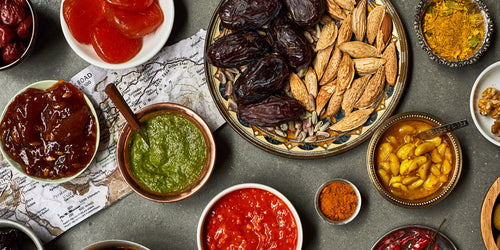Your Cart is Empty
Editor’s note: Michael Harlan Turkell is an award-winning photographer and the author of Acid Trip: Travels in the World of Vinegar, an astounding globe-trotting investigation into the culture and chemistry of vinegar-brewing traditions around the world. This excerpt follows his journey to meet Akihiro Iio, the fifth generation of his family to run the Iio Jozo vinegar brewery near Miyazu Bay, and the maker of our favorite purple sweet potato vinegar.
Amanohashidate, a sandbar grown thick with pines, is one of Japan’s three most celebrated scenic sights. This “bridge to heaven” extends through Miyazu Bay, just off the Sea of Japan, in northern Kyoto prefecture. I sat on the terrace of Genmyoan, a hilltop ryokan, with Akihiro Iio and his wife, sipping coffee and admiring the “flying dragon view,” as they call it. The Iio Jozo vinegar brewery is five generations old, and when Akihiro took over only five years ago, he became the bridge connecting rice vinegar’s past to its future.
In 1893, Akihiro Iio’s great grandfather Chozo began making Fujisu, their house brand; Iio’s father, Tsuyoshi, and mother, Satomi, carried on this tradition, fermenting rice, apples, figs, black beans, and even purple potatoes, all for the sake of making vinegar. I was struck by Akihiro’s quiet confidence; he carried himself with a seriousness and a deeply rooted commitment to the craft—we’re talking about someone who grows his own rice in order to brew his own sake in order to make vinegar. From April to October he tends to the rice paddies, all located within the region. Between April and the following January he makes sake, and though vinegar is made year round, it’s this regimented cycle that sets him apart and gives Fujisu the deserving title of “premium” vinegar. There’s even a small quantity of vinegar made from rice grown merely a few miles away from the brewery in Miyazu.
In the 1960s, Akihiro’s grandfather, Terunosuke, stopped using chemical pesticides. The yields lowered at first, but the resulting quality of their product ultimately launched Iio Jozo as a significant player in the vinegar scene. This same investment in value also extended to their touching hospitality—known in Japan as omotenashi. When I first arrived at his parents’ house, I was received with such sincerity that I felt a sense of déjà visite; despite never having visited before, it felt like being welcomed back. A grill was smoking in the backyard, lit with dried rice straw (they truly utilize every part of their crop). A piece of mackerel was lightly marked on one side, touched with just enough heat to bring out its tenderness.
A buffet followed: soulful dishes with pork, chives, and daikon; another of salmon, onions, and sansho; but describing these dishes doesn’t begin to capture the peace and enjoyment I felt eating Akihiro’s food.
In particular, I found myself enraptured by a bowl of rice—who would’ve thought? I breathed “itadakimasu,” which loosely means, “I humbly receive,” a common benediction before a meal. Rice vinegar, poured over a fanned wooden spoon, seasoned the shari (sushi rice), embracing every single grain. It sat in a hangiri (a wooden bowl) as it continued to cool, absorbing all the flavor of the vinegar.

Some people call Akihiro the “Temaki King.” He even has it in gold lettering on a second business card. Temaki are sushi hand rolls, a meal that many Japanese families delightedly feast on with rice and all the fixings, as if it were Taco Tuesday in the United States. The grilled mackerel reappeared: with palm-size squares of seaweed, beef, and sesame and a side of myoga ginger and perilla and shiso.
“Oishii, oishii,” I chanted with a mouthful of temaki. “So delicious, I can barely eat any more.” “Okay, only one more thing,” said Akihiro. He placed a portable burner on the table and raised the lid on a boiling donabe (clay pot). A cloud of steam drifted toward me, like that come-hither finger you see in cartoons.
Shabu-shabu, which I consider “Japanese fondue,” is a close cousin of the “hot pot,” and a wonderful onomatopoeic phrase that refers to the sound the ingredients make when they are stirred in a pot. First, meat and vegetables are dipped into a boiling donabe filled with water or dashi that becomes flavored by all the ingredients plunged into it, and when they’re cooked to your liking, you add them to your own personal bowl, with a splash of ponzu as you please. Akihiro’s shabu-shabu was fantastic—but we weren’t finished yet. The grand finale: vanilla ice cream topped with a drizzle of benimosu, Akihiro’s prized purple potato vinegar. I practiced a few times in my head, saying “gochiso sama deshita!” (“It was quite a feast!”), and the instant the table was cleared and before another course materialized, I murmured it out, fuller than I’ve ever been in my life.
Akihiro led me a short car ride away to sample freshly pressed sake at the brewery, a space buzzing with palpable energy in the air. It was the off-season for sake making, so most of the employees were peeling green apples (the ones Yoko Ono made famous) for cider (and inevitably vinegar). What’s important to note is vinegar must move through several key and precise stages in order to reach its desired form. Accordingly, Iio Jozo knows to leave nothing to chance.

More than 90 percent of Japan’s vinegar comes from ethyl alcohol that was made commercially in anywhere from eight to forty-eight hours. Iio Jozo’s takes from forty to one hundred days. Add the 180 days to grow the rice, and we’re already at two-thirds of a year without starting on acetic acid. Most of their vinegars take about one hundred days to convert, and then more than 250 days of aging. In total, from grain to bottle, we’re looking at about two years’ time, and that’s just for baseline vinegar. Their akasu takes twelve years!
Wallpapering the vinegar factory are infographics explaining things like the degree to which koshihikari rice is polished, and why that matters; why it’s important to steam the potatoes first (to help break down and covert the carbohydrates into sugar), but only after cutting off the fibrous ends that can impede the process; and how Iio Jozo initiates the course of fermentation with exactly 10 percent koji. There’s a poster that states one of their rarer vinegars, black bean, has higher polyphenol levels than many red wines, and three times the amino acid. It ages nine years until it reaches it maturity, and every step of the way Akihiro stays attuned to its biorhythms, its transformation slow but sure.
In the fermentation room, a smell like that of Beaujolais’s gamay grapes—a favorite variety of mine—filled my nose, yet I was quite a distance away from the Loire Valley in France, where gamay grapes are grown. Gripping the top rung of a ladder, I leaned over an open vat to discover not grapes but pretty violet tubers fermenting before my very eyes.
Buy Acid Trip from Abrams Books, and try Iio Jozo’s purple sweet potato vinegar for yourself.
Michael Harlan Turkell is an award-winning food photographer and writer. He has photographed and co-authored many prominent chefs’ cookbooks, as well as written one of his own, ACID TRIP: Travels in the World of Vinegar, which won the 2018 IACP Cookbook Award for Culinary Travel. He also hosts The Food Seen & Modernist BreadCrumbs on Heritage Radio Network, as well as Season 3 of Food52's Burnt Toast podcast. He lives in Brooklyn, New York.





